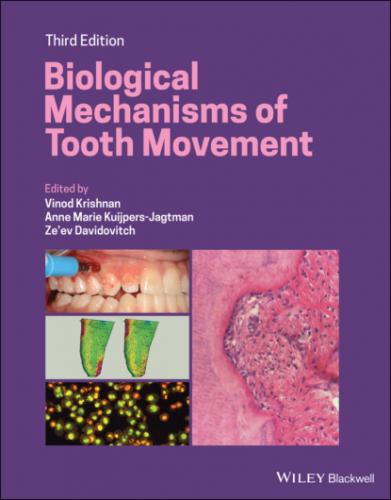Biological Mechanisms of Tooth Movement. Группа авторов
Pavlin et al. (2001) and Gluhak‐Heinrich et al. (2003) highlighted the importance of osteocytes in the bone remodeling process. They showed that the expression of dentine matrix protein‐1 mRNA in osteocytes of the alveolar bone increased twofold as early as 6 hours after loading, at both sites of formation and resorption. Receptor studies have proven that these cells are targets for resorptive agents in bone, as well as for mechanical loads. Their response is reflected in fluctuations of prostaglandins, cyclic nucleotides, and inositol phosphates. It was, therefore, postulated that mechanically induced changes in cell shape produce a range of effects, mediated by adhesion molecules (integrins) and the cytoskeleton. In this fashion, mechanical forces can reach the cell nucleus directly, circumventing the dependence on enzymatic cascades in the cell membrane and the cytoplasm.
Figure 1.17 A 6 μm sagittal section of the same maxilla shown in Figure 1.16, but derived from the other canine that had been tipped distally for 24 hours by a coil spring generating 80 g of force. The PDL and alveolar bone‐surface cell in the site of PDL tension are stained intensely for PGE2.
Figure 1.18 Immunohistochemical staining for cyclic AMP in a 6 μm sagittal section of a cat maxillary canine untreated by orthodontic forces (control). The PDL and alveolar bone surface cells stain mildly for this cyclic nucleotide.
Figure 1.19 Staining for cyclic AMP in a 6 μm sagittal section of a cat maxillary canine subjected for 24 hours to a distalizing force of 80 g. This section, which shows the PDL tension zone, was obtained from the antimere of the control tooth shown in Figure 1.18. The PDL and bone surface cells are stained intensely for cyclic AMP, particularly the nucleoli.
Figure 1.20 Staining for cyclic AMP in the tension zone of the PDL after 7 days of treatment. The active osteoblasts are predominantly round, while the adjacent PDL cells are elongated. All cells are intensely stained for cAMP.
Figure 1.21 Immunohistochemical staining for IL‐1β in PDL and alveolar bone cells near a cat maxillary canine untreated by orthodontic forces (control). The PDL and alveolar bone surface cells are stained lightly for IL‐1β.
Figure 1.22 Staining for IL‐1β in PDL and alveolar bone surface cells after 1 hour of compression resulting from the application of an 80 g distalizing force to the antimere of the tooth shown in Figure 1.21. The cells stain intensely for IL‐1β in the PDL compression zone, and some have a round shape, perhaps signifying detachment from the extracellular matrix. × 840.
Efforts to identify specific molecules involved in tissue remodeling during OTM have unveiled numerous components of the cell nucleus, cytoplasm, and plasma membrane that seem to affect stimulus‐cell interactions. These interactions, as well as those between adjacent cells, seem to determine the nature and the extent of the cellular response to applied mechanical forces. The receptor activator of nuclear factor kappa B ligand (RANKL) and its decoy receptor, osteoprotegerin (OPG) were found to play important roles in the regulation of bone metabolism. Essentially, RANKL promotes osteoclastogenesis, while OPG inhibits this effect. The expression of RANKL and OPG in human PDL cells was measured by Zhang et al. (2004). The cells were cultured for 6 days in the presence or absence of vitamin D3, a hormone that evokes bone resorption. The expression of mRNA for both molecules was assessed by RT‐PCR, while the level of secreted OPG in the culture medium was measured by ELISA. It was found that both molecules were expressed in PDL cells, and that vitamin D3 downregulated the expression of OPG and upregulated the expression of RANKL. These results suggest that these molecules play key roles in regulating bone metabolism. The response of human PDL and osteoblast‐like cells to incubation for 48 hours with PGE2 revealed that both cell types were stimulated to express RANKL, but that the bone cells were significantly more productive in this respect. When the cells were co‐cultured with osteoclast‐like cells, the osteoblasts evoked osteoclastogenesis significantly greater than the PDL cells (Mayahara et al., 2012). Recent studies in this regard have confirmed the same in human volunteers (Otero et al., 2016) and were even able to establish a clear role between RANKL production and the root resorption process associated with OTM (Yamaguchi, 2009).
The abovementioned studies illuminate information on the biological aspects of OTM but many gaps still remain. Tooth movement is primarily a process dependent upon the reaction of cells to applied mechanical loads. It is by no means a simple response, but rather a complex reaction. Components of this reaction have been identified in experiments on isolated cells in vitro. However, in this environment the explanted cells are detached from the rest of the organism and are not exposed to signals prevailing in intact animals. In contrast, in orthodontic patients the same cell types are exposed to a plethora of signal molecules derived from endocrine glands, migratory immune cells, and ingested food and drugs. A review of pertinent literature published between 1953 and 2007 by Bartzela et al. (2010) revealed details on the effects and side‐effects of commonly used medications on tooth movement. Nonsteroidal anti‐inflammatory drugs and estrogen were found to decrease OTM, whereas corticosteroids, PTH, and thyroxin seem to accelerate it. However, the individual responses to these medications may differ significantly from patient to patient, and such differences may have profound effects on treatment duration and outcomes. This fact implies that an orthodontic diagnosis should include information about the overall biological status of each patient, not merely a description of the malocclusion and the adjacent craniofacial hard and soft tissues. Moreover, periodic assessments of specific biological signal molecules
